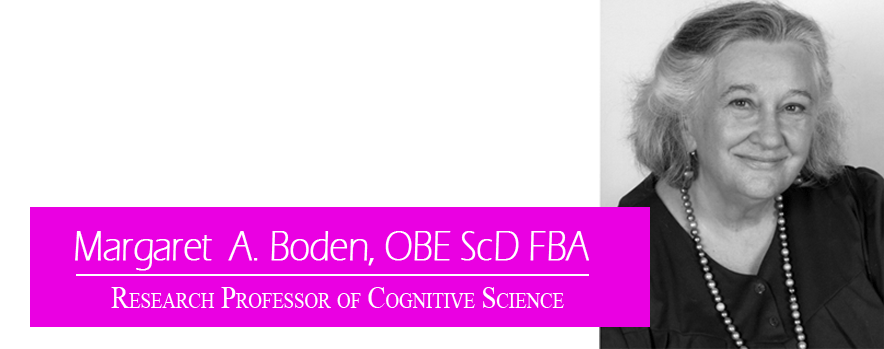|
| My key publications are all books, not papers. (However, some key-ish papers are included in the next section, “Selected Papers”.) |
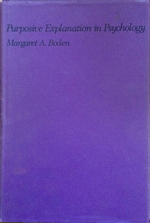 |
Purposive Explanation in Psychology.
Harvard University Press, 1972.
This book is the root of all my subsequent thinking. Discussing a wide range of work in philosophy, theoretical psychology, and very early AI, it seeks to clarify how purpose, freedom, and human personality can exist in a basically materialist universe. |
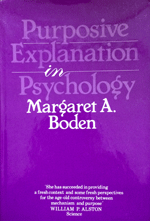 |
The cover of the reprinted edition (Harvester Press, 1978) quoted the philosopher William Alston, writing in Science: “She has succeeded in providing a fresh context and some fresh perspectives for the age-old controversy between mechanism and purpose.” |
| |
|
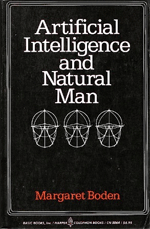 |
Artificial Intelligence and Natural Man.
Harvester/Basic Books, 1977.
2nd edition (expanded), MIT Press/Basic Books, 1987.
In my own mind, this is a “footnote” to Purposive Explanation. It describes many examples of AI that didn’t exist when the earlier book was being written. It was very widely read, because it was the first book on general AI (although Bert Raphael’s on robotics had appeared a few months earlier), and the first to describe many individual programs in significant detail—but without using a single line of code. It was also the first to highlight the philosophical, psychological, and social implications of AI, discussed in the last three chapters. (The 2nd edition added a “Postscript” mentioning AI developments since the mid-1970s.) |
| |
|
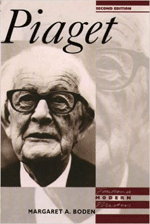 |
Piaget.
Fontana Modern Masters, 1979.
2nd edn (expanded), 1995.
This book highlights how Piaget applied his ideas to philosophy and biology, as well as psychology. It also compares his formalism to the computational approach. The 2nd edition adds a Preface comparing Piaget’s work to recent research in developmental psychology and A-Life. |
| |
|
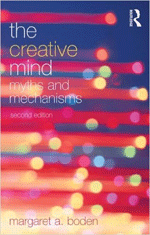 |
The Creative Mind: Myths and Mechanisms.
Weidenfeld & Nicolson/Basic Books, 1990/91.
2nd edn. (revised & expanded), Routledge, 2004.
In effect, The Creative Mind is an elaboration of Chapter 11 (“Creativity”) of Artificial Intelligence and Natural Man. Written in a highly accessible style, it clarifies the concept of creativity, and asks how it is possible. It distinguishes three kinds of creativity, and also discusses computer models of creativity in art and science. It’s best read in the 2nd edition (2004), which (besides a few revisions within the main text) has a précis of my approach, plus a new chapter describing computer models that didn’t exist when the book was written. |
| |
|
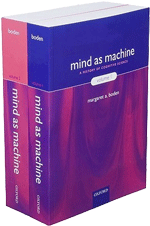 |
Mind as Machine: A History of Cognitive Science, 2 vols.
Oxford/Clarendon Press, 2006.
Mind as Machine integrates the various disciplines that are relevant for understanding the human mind. It ranges from anthropology to neuroscience, and from comparative religion to the nature of life. It enables individual readers to see fundamental links between their own specialism and others (and, thanks to the accessible style, to learn about those disciplines which are unfamiliar to them). The final chapter lists some hostages to fortune: the work in current cognitive science that I regard as most promising.
Section 1.i.a, “Questions, questions…”, lists some of the puzzles discussed in the book--most of which occur to anyone with intellectual curiosity : see the PDF here.
The “Analytical Table of Contents" for Mind as Machine indicates the topics discussed in the book : see the PDF here.
|
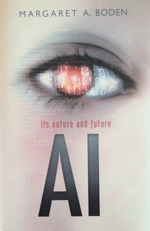 |
AI, Its Nature and Future
Oxford University Press (published May 2016).
An introduction to AI/A-Life. It includes a philosophical chapter (“But Is It Intelligence, Really?”), and another showing how the recent panic about “the Singularity” is changing the direction of AI research, and encouraging careful evaluation of its social implications.
Described in Nature as a “masterclass of a book". |
| key publications | selected papers | other single-authored books | forthcoming books | edited books |
|
| The papers listed below aren’t all recent. Indeed, some have already been reprinted, in my own collections and elsewhere. They are selected here partly because they’re among my own favourites, and partly to indicate the interdisciplinary nature of my research. |
| |
|
| 1. |
Boden, M. A. (2014), “Aaron Sloman: A Bright Tile in AI’s Mosaic". In J. L. Wyatt, D. Petters, and D. Hogg (eds.), From Animals to Robots and Back: Reflections on Hard Problems in the Study of Cognition. A Collection in Honour of Aaron Sloman. (London: Springer), pp. 9-30.
A discussion of Sloman’s research since the 1970s. In Mind as Machine, I identify his work as perhaps the most promising in AI/cognitive science today. See the PDF here.
|
| |
|
| 2. |
Boden, M. A., (2014) “Artificial Intelligence and Creativity: A Contradiction in Terms?” In E. S. Paul and S. B. Kaufman (eds.), The Philosophy of Creativity (Oxford University Press), pp. 224-244.
Argues that this question can’t be definitively answered. That’s primarily because of the (disputed) role of consciousness in creativity, and also the (disputed) concept of consciousness—which may or may not have a computational analysis. See the PDF here.
|
| |
|
| 3. |
Boden, M. A. (2013), "Creativity as a Neuroscientific Mystery". In O. Vartanian, A. Bristol, and J. C. Kaufman (eds.), The Neuroscience of Creativity (Cambridge, Mass.: MIT Press), pp. 3-18.
Argues that neuroscientists cannot explain creativity unless they focus on the relevant high-level information-processing going on in the brain--which, for them, is especially problematic with regard to exploratory and transformational creativity. See the PDF here:
|
| |
|
| 4. |
Boden, M. A. (2010), “Personal Signatures in Art”. In (Boden 2010), pp. 92-124.
This contains a discussion of a robotics research project asking whether evolutionary art could produce a fundamentally new, unrecognizable, style. See the PDF here:
|
| |
|
| 5. |
Boden, M. A., and Edmonds, E. A. (2009), “What Is Generative Art?”, Digital Creativity, 20(1-2): 21-46. (Reprinted in Boden 2010.)
Provides a taxonomy of the various kinds of computer art, and indicates which philosophical problems relate to each type. A slightly amended version is in the PDF here:
|
| |
|
| 6. |
Boden, M. A. (2008),“Odd Man Out: Reply to Reviewers”, Artificial Intelligence, 172(18): 1944-1964.
The final Section provides my response to Noam Chomsky’s defamatory attack on the ‘linguistics chapter’ in Mind as Machine: Chomsky, A. N. (2007), “Symposium on Margaret Boden, Mind as Machine: A History of Cognitive Science. Oxford (2006)”, Artificial Intelligence, 171(18): 1094-1103. (The PDF on this website contains only the Chomsky-relevant part of this “Reply”: see the PDF here:
|
| |
|
| 7. |
Boden, M. A. (2008) “D’Arcy Thompson: A Grandfather of A-Life”. In P. Husbands, O. Holland, and M. Wheeler (eds.), The Mechanical Mind in History (MIT Press), pp. 41-60.
Shows how D’Arcy Thompson’s mathematical biology, and Turing’s work on morphogenesis, can be seen as intellectual successors of Goethe’s morphology. See the PDF here:
|
| |
|
| 8. |
Boden, M. A. (2004) “In a Nutshell”.
The prologue to the 2nd edition of my book The Creative Mind, this gives a précis of my account of creativity. See the PDF here:
|
| |
|
| 9. |
Boden, M. A. (2000), “Crafts, Perception, and the Possibilities of the Body”, British Journal of Aesthetics, 40: 289-301. (Reprinted in Boden 2010.)
Provides a psychological basis for the problematic distinction between “art” and “craft”, and explains why that distinction can never be neatly exclusive: some artefacts will satisfy both sets of psychological criteria . See the PDF here:
|
| |
|
| 10. |
Boden, M. A. (1999), “Is Metabolism Necessary?”, British Journal for the Philosophy of Science, 50(2): 231-48. . (Reprinted, with minor amendments, as “Alien Life: How Would We Know?”, International Journal of Astrobiology, 2003, 2(2): 121-129; also reprinted in M. A. Bedau & C. Cleland (eds.), The Nature of Life: Classical and Contemporary Perspectives from Philosophy and Science (Cambridge University Press, 2003), pp. 249-259;
also reprinted in Boden 2010.)
Argues that metabolism is an irreducibly physical, not informational, concept, so “strong” A-Life is impossible. See the PDF here:
|
| |
|
| 11. |
Boden, M. A. (1973), “The Structure of Intentions”, Journal for the Theory of Social Behaviour, 3(1): 23-46. (Reprinted in Boden 1981.)
Gives a computationally informed analysis of intentions: cf. Boden 1959. See the PDF here:
|
| |
|
| 12. |
Boden, M. A. (1966) “Optimism”, Philosophy, XLI: 291-303. (Reprinted in D. Benatar (ed.), Life, Death and Meaning: Key Philosophical Readings on the Big Questions (Rowman & Littlefield), 1st and 2nd edns. , 2004 and 2010 ; also reprinted in Boden 1981.)
Argues that most forms of optimism make factual claims, and recommend certain—disputable--values; so optimism should not be instantly dismissed, but subjected to rational argument. See the PDF here:
|
| |
|
| 13. |
Boden, M. A. (1965), “McDougall Revisited”, Journal of Personality, 33(1): 1-19.
Written while I was a graduate student at Harvard, this was the seed of Purposive Explanation in Psychology-–and thus of all my later work. See the PDF here:
|
| |
|
| 14. |
Boden, M. A. (1959), “In Reply to Hart and Hampshire”, Mind, LXVIII: 256-60.
Published while I was still at Cambridge (see “Intellectual Autobiography”), the topic—freewill, or intention—remained central to my later thinking. But, without the benefit of computational ideas, its approach was very different!: cf. Boden 1973. See the PDF here:
|
| key publications | selected papers | other single-authored books | forthcoming books | edited books |
single-authored books not listed above: |
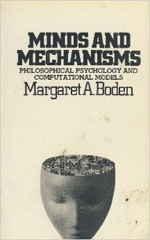 |
Minds and Mechanisms:
Philosophical Psychology and Computational Models.
Harvester Press/Cornell University Press, 1981.
A collection of some of my early papers. (NB these papers were collected within a single volume because they had originally appeared in highly diverse sources.) |
| |
|
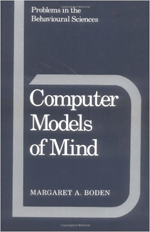 |
Computer Models of Mind:
Computational Approaches in Theoretical Psychology.
(Series: Problems in the Behavioural Science.)
Cambridge University Press, 1988.
This book details various theories in cognitive psychology that were inspired by early AI. |
| |
|
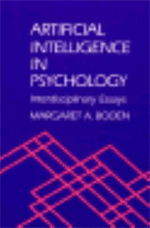 |
Artificial Intelligence in Psychology: Interdisciplinary Essays.
MIT Press, 1989.
Another collection of my papers. |
| |
|
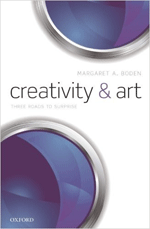 |
Creativity and Art: Three Roads to Surprise
Oxford University Press, 2010.
Half about traditional art and half about computer art, this collection contains two original papers and nine reprinted from very diverse sources. |
| |
|
| key publications | selected papers | other single-authored books | forthcoming books | edited books |
|
 |
Artificial Intelligence: A Very Short Introduction
Oxford University Press (forthcoming, probably Spring 2017).
The paperback version of AI, Its Nature and Future. |
| |
|
|
|
| |
M.A. Boden and E.A. Edmonds, From Fingers to Digits: Towards a New Aesthetic.
MIT Press/Leonardo. forthcoming.
Ernest Edmonds was one of the very first computer artists (and also wrote the first logic-programming language), and his artwork is now world-famous. This collection of essays (half by him, half by me) provides historical and philosophical reflections on computer art. |
| |
|
| key publications | selected papers | other single-authored books | forthcoming books | edited books |
|
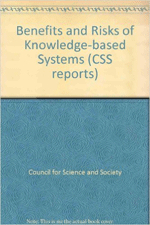 |
Benefits and Risks of Knowledge-Based Systems. (Report of a Council for Science and Society working-party, chaired by M. A. Boden.)
Oxford University Press, 1989. |
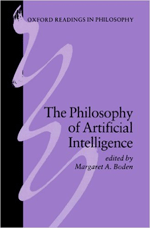 |
The Philosophy of Artificial Intelligence, ed. M. A. Boden. (Series: Oxford Readings in Philosophy.)
Oxford University Press, 1990. |
 |
Dimensions of Creativity, ed. M. A. Boden.
MIT Press, 1994. |
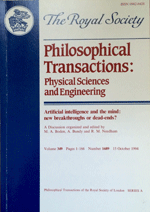 |
Artificial Intelligence and the Mind: New Breakthroughs or Dead Ends?, eds. M. A. Boden, A. Bundy & R. M. Needham. Special Number of Phil. Trans. Royal Society (A), January 1995.
Oxford University Press, 1995. |
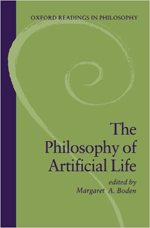 |
The Philosophy of Artificial Life, ed. M. A. Boden. (Series: Oxford Readings in Philosophy.)
Oxford University Press, 1996. |
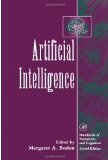 |
Artificial Intelligence, ed. M. A. Boden. (Vol. 14 of 2nd edn., Handbook of Perception and Cognition.)
Academic Press, 1996. |
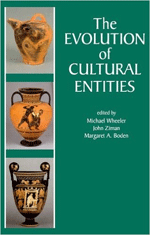 |
The Evolution of Cultural Entities, eds. M. W. Wheeler, J. Ziman, & M. A. Boden.
Oxford University Press, 2002. |
| |
|
| key publications | selected papers | other single-authored books | forthcoming books | edited books |
|
|
